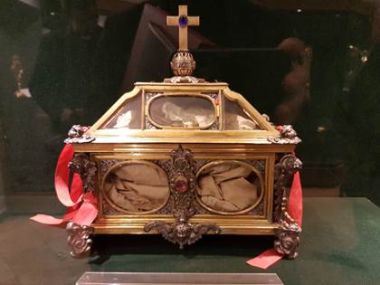Rare relic of Thomas Becket returns to Canterbury Cathedral in anniversary year

2020 marks 850 years since Thomas Becket's murder in 1170, and 800 years since his remains were moved from the crypt of Canterbury Cathedral to a new shrine.
As part of the commemorations, a vestment that is traditionally believed to have been worn by Becket at the time of his murder in Canterbury Cathedral is coming to the UK.
The garment, known as a tunicle, dates back to the 12th century and is housed inside an exquisite 17th century glass reliquary.
It is being loaned to the cathedral by the Vatican and will go on display from 4 July to 3 August, overlapping the Lambeth Conference, which is bringing together bishops from around the entire Anglican Communion.
The cathedral said that the artefact would provide a focus of prayer for the thousands of pilgrims expected to visit Canterbury over the summer, and a historical perspective to the bishops attending the Lambeth Conference.
Precentor of Canterbury Cathedral, the Rev Max Kramer, said: "The relic reminds us of the cost of bearing faithful witness to Christ.
"Many of the Bishops who will be attending the Lambeth Conference lead Christian communities suffering violent persecution and oppression for their faith.
"We hope that seeing the garment associated with Becket's death, and being reminded of his extraordinary legacy will help them to find the strength and encouragement of God as they continue to witness to our shared faith with great courage in difficult times."
Becket was murdered inside Canterbury Cathedral on 29 December 1170 by four knights who believed that slaying him was the wish of Henry II, at one time a close friend of the archbishop's.
Edward Grim, a monk who was with Becket when he was killed, gave a horrific account of the murder, which was recorded as having been so violent that the tip of a sword's blade was shattered on the cathedral pavement and the crown of Becket's head sliced off.
After his death, Becket's popularity only grew and he was made a saint after miracles were attributed to him. King Henry II eventually did public penance by walking barefoot to Canterbury Cathedral, where he was flogged by monks.
The tunicle is going on display as part of Becket2020, a yearlong programme of services, events and exhibitions in Canterbury, London and elsewhere in the UK to commemorate Becket's remarkable life, death and legacy.











